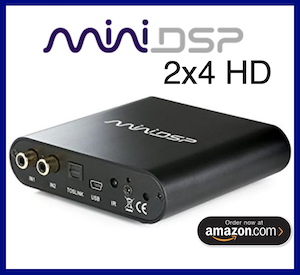David Eisan
Registered
Thread Starter
- Joined
- Mar 8, 2018
- Posts
- 10
More
- Main Amp
- Eisan
Hello,
For the last year I had been using REW with a UMIK-1 for measuring drivers to import into crossover design software to build speakers, but the timing info was not perfect and the phase between drivers was not always giving me the results in real life the crossover design software said I should be getting. I had been using gated measurements (3-4ms depending) and exporting minimum phase versions of the sweeps. Of course I was also doing nearfield measurements and splicing them to the gated measurements and using software to model/overlay bafflestep.
After reading a lot on the forums about what I thought I needed for better measurements I bought a Focusrite Solo and an EMM-6 to take better measurements and I have found a whole new learning curve. This isn't nearly as plug and play as a UMIK-1, but I am hoping it will yield more accurate results.
The Focusrite Scarlett Solo is installed, soundcard calibration is done and the mic is working. Loop back is from the right channel RCA out to the 1/4" jack in on the front. Output is from the left channel RCA out to my preamp/poweramp/speaker box I want to test. Microphone is obviously connected to the XLR on the front, phantom power is turned on.
With the loop back I am getting distance measurements between the mic and the drivers being tested.
A couple of questions.
It seems like I also need a separate dB meter to calibrate the dB readings in REW that I didn't need with the USB UMIK-1. I used a Dayton iMM-6 with my phone to set the dB by playing pink random and comparing what REW was hearing with what my phone was reading in the same position as the EMM-6 and making the correction.
Are there some base guidelines for settings on mic gain, loopback input gain and monitor out to preamp?
Once I set these, it would seem that they should be left alone and never touched, or calibrating the dB will have to be done again.
How do I set the mic and loopback headroom to be similar (do they need to be?), and just what should that headroom be?
Any hints on setup for measuring drivers with this setup?
Is there a simple guide for using REW with a non-usb mic for speaker builders?
I spent about 4 hours on this tonight learning and setting up, I hope I can do some useful measuring tomorrow!
Thank you,
David - London, Canada.
For the last year I had been using REW with a UMIK-1 for measuring drivers to import into crossover design software to build speakers, but the timing info was not perfect and the phase between drivers was not always giving me the results in real life the crossover design software said I should be getting. I had been using gated measurements (3-4ms depending) and exporting minimum phase versions of the sweeps. Of course I was also doing nearfield measurements and splicing them to the gated measurements and using software to model/overlay bafflestep.
After reading a lot on the forums about what I thought I needed for better measurements I bought a Focusrite Solo and an EMM-6 to take better measurements and I have found a whole new learning curve. This isn't nearly as plug and play as a UMIK-1, but I am hoping it will yield more accurate results.
The Focusrite Scarlett Solo is installed, soundcard calibration is done and the mic is working. Loop back is from the right channel RCA out to the 1/4" jack in on the front. Output is from the left channel RCA out to my preamp/poweramp/speaker box I want to test. Microphone is obviously connected to the XLR on the front, phantom power is turned on.
With the loop back I am getting distance measurements between the mic and the drivers being tested.
A couple of questions.
It seems like I also need a separate dB meter to calibrate the dB readings in REW that I didn't need with the USB UMIK-1. I used a Dayton iMM-6 with my phone to set the dB by playing pink random and comparing what REW was hearing with what my phone was reading in the same position as the EMM-6 and making the correction.
Are there some base guidelines for settings on mic gain, loopback input gain and monitor out to preamp?
Once I set these, it would seem that they should be left alone and never touched, or calibrating the dB will have to be done again.
How do I set the mic and loopback headroom to be similar (do they need to be?), and just what should that headroom be?
Any hints on setup for measuring drivers with this setup?
Is there a simple guide for using REW with a non-usb mic for speaker builders?
I spent about 4 hours on this tonight learning and setting up, I hope I can do some useful measuring tomorrow!
Thank you,
David - London, Canada.












